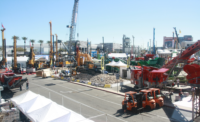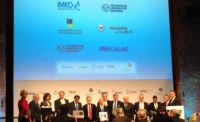As the world’s largest equipment manufacturers convened in Munich for the Bauma equipment show April 4-14, the overriding question was what has changed in the industry since the last show three years ago. Well over half a million attendees came out to Bauma to see what the next big thing in construction equipment will be, and the proliferation of battery-driven equipment—encroaching on diesel-power’s dominance—was what turned heads.
While equipment manufacturers have largely met the technical challenges of complying with stringent emissions requirements in the U.S. and the European Union, even tougher rules in some urban areas and advances in battery technology are changing the face of compact equipment. Leading the charge at the show was Volvo Construction Equipment, which unveiled the commercially available models of its battery-powered compact excavator and wheel loader previewed earlier this year (ENR 2/18-25 p. 10).
“We announced that we will go fully electric on our compact excavator range and on our compact wheel loader range from 2020,” noted Melker Jernberg, Volvo CE president. The initial models, the ECR25 compact excavator and L25 compact wheel loader, were unveiled at the show, and are designed to recharge off standard grid power. “These are going to be most suitable for use in cities, very good in buildings,” explains Jernberg. “We can charge them with a normal power outlet or with a quick charger. So one working day and then charge during the night, or go in for a quick charge.”
Word about Volvo CE’s plans must have generated interested, because other equipment manufacturers and suppliers were eager to highlight the electric-powered and alternative-fuel concept machines they have been working on.
Drivetrain manufacturer Dana highlighted the company’s recent innovations in drivetrains tuned for battery-powered machines under its Spicer brand, and also had all-electric compact equipment prototypes running at the company’s outdoor display. “We are energy-source agnostic,” explains Dana CEO and President Jim Kamsickas. “We’re the leader in the hybridization and electrification in mobility markets,” he says, explaining that both internal research and recent acquisitions have positioned Dana for broader adoption of battery-electric and hybrid machines in the off-highway market. “We do the motors, the inverters, the controllers, and the thermal management,” says Kamsickas. “And [with electrification] thermal management is very important.”
Not to be outdone, engine maker Cummins was also quick to show off a concept electric compact excavator at its display next to its recently introduced and updated Tier 4 Final diesel engines.
Taking a different tack on the electrification and renewables trend at Bauma, Case Construction Equipment unveiled Project Tetra, a concept design for a medium wheel loader that runs off of compressed biomethane. Using a renewable energy source, the concept machine also produces far lower emissions levels than a traditional diesel-powered wheel loader. While only a concept machine, Case CE representatives made it clear the company is looking beyond traditional fossil fuels for its medium and large equipment.
German-based Liebherr also devoted a portion of its massive booth at the show to new electric machines. The vehicles are mostly targeted for mining but are also finding general use. Models at the show included the new LB 16 battery-driven, all-electric deep-foundation drilling rig featuring an electric-hydraulic drive, available in Europe in July of 2019; the diesel-electric hybrid T236, a 210-metric-ton mining truck, which, having completed its testing phases, is now in service in Austria and South Africa and due soon for general release; an electric-drive mining excavator, the R 9200 E, first delivered to Bosnia-Herzegovina at the beginning of 2018 and due to go on the more general market in a few months; and the ETM electric-drum-drive truck mixer, available in third quarter of 2019.
“For us it is really about the future of alternative drives: change is coming and we want to find the best solutions,” Liebherr spokeswoman Anja Merker told ENR. For jobsites found in denser urban areas, electric machines offer a quieter and cleaner alternative. The ETM drum mixer reflects this shift, with its less noisy electric drum drive mounted on a MAN chassis. Liebherr also plans to offer an electric-powered stationary concrete pump for high-rise projects.
German officials sparked a broader and even Europe-wide rethink of fossil-fuels last year, as cities including Stuttgart—home to automakers Daimler and Porsche—and Hamburg enacted bans on diesel automobiles. Even industrial clients are thinking about alternative drive trains, Merker says, and Liebherr wants to get out in front. They are not the only equipment manufacturers to do so. Also possibly taking a page from Volvo, Sweden-based Scania showed off a hybrid mixer at Bauma, with the mixer running on electricity and the truck on compressed natural gas.
Terex Explains Sale of Demag Crane Unit
Some of the bigger splashes at Bauma were just companies seeking to reassure customers about the state of their business. Equipment manufacturing giant Terex took the stage at the trade show to clarify the terms of its announced sale of its Demag cranes to Japan-based Tadano.
“Demag has been with us twenty-plus years,” says John Garrison, CEO and president of Terex. But after considering how it would fit into a broader realignment taking place across Terex’s businesses, “we came to the conclusion, there’s incredibly strong industrial logic to combine it with Tadano,” he says.
Garrison told ENR he expects the deal to close by midyear, clearing all regulatory hurdles. Terex is also ending production of cranes in North America, shuttering a manufacturing facility in Oklahoma City and ending product lines for rough terrain cranes, boom trucks and crossover cranes. Production of RT cranes and tower cranes will continue at its facilities in Italy, but there are no plans to resume production in the U.S. Despite the Demag deal, Garrison says there are no plans to sell off other major Terex brands such as Genie aerial work platforms.
3D-Printed Concrete Initiative Advances
German-based formwork giant Doka had a lot of offerings on display at the show, but the company also provided ENR new information about a partner firm focusing on 3D printing concrete. Contour Crafting, a private venture set up by the University of Southern California professor and engineer Behrokh Khoshnevis, is 30% owned by Doka and is nearing its first major project in the U.S., according to Werner Bittner, Contour Crafting board chairman.
The first job for the gantry-based 3D printer will consist of six concrete structures, each about 60 sq meters, to be built in a yet-to-be-named U.S. city on the West Coast. They will be built with the firm’s proprietary 3D concrete printers, which can print in spans of up to 40 m.
Once the buildings are complete, Doka’s corporate parent, Umdasch Group, plans to purchase several of the concrete printers and launch a building printing-as-a-service venture, Bittner told ENR. Pricing has yet to be announced. Unlike other concrete 3D printers, the Contour Crafting system can print using standard concrete with only a mild admixture, and requires no formwork. “Only concrete is concrete,” Bittner told ENR.
By Jeff Rubenstone in Munich, with Michael Dumiak









Post a comment to this article
Report Abusive Comment